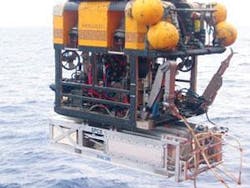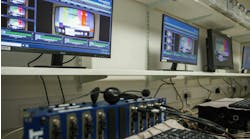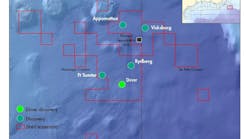Ted Moon • Houston
Two contracts for Subsea 7
ConocoPhillips Skandinavia AS has awarded Subsea 7 two North Sea contracts initially valued at $69 million. The first is for work on the Ekofisk 2/4 FTP by-pass project in water depths ranging to 80 m. The contract, worth approximately $32 million, calls for Subsea 7 to provide engineering, procurement, fabrication, construction, removal, and pre-commissioning of the subsea pipeline system for the project.
It will also entail the fabrication and installation of approximately 500 m of spools, a 90-m riser, and platform work. This is a continuation to pipeline bundle work that was awarded to Subsea 7 earlier in 2005. Installation work is scheduled for 2006.
ConocoPhillips has an option to keep Subsea 7 on for further project work that would include fabrication and installation of approximately 470 m of spools, de-commissioning of existing systems, surveying, metrology, and testing. This additional work has a price tag of approximately $23 million.
The second contract is for a pipeline bypass around the Norpipe H7 gas booster platform, located in the German sector of the North Sea at a water depth of 40 m. The $37-million project will include all facets of engineering and installing a 36-in. nominal diameter bypass, which will be tied into the existing Norpipe Gas Export Pipeline system. ConocoPhillips awarded this contract on behalf of its partner Gassco, who is the operator of the Norpipe.
Offshore work for this second contract will take place in 2006 and 2007, and the major diving campaign will be performed in mid 2007.
New subsea valve
A collaborative effort between Weir Valves & Controls UK and Weir Norge has produced a new valve for controlling MEG dosage applications on christmas trees. The first two templates will be used by local EPIC contractor FMC Kongsberg Subsea AS on trees in the Ormen Lange (Sea Serpent) project at water depths of 1,100 m.
More orders have come in for applications in the North Sea, according to Weir Norge. The first significant order had a value of $1.4 million, and was for eight 2 1/16-in. API 5000 units, which includes the qualification of the Valves and Dantorque Actuators. Another order is expected in July 2006 for eight more units valued at approximately $1.2 million. Over the next three years, Weir Norge expects a total of 54 valves to be ordered.
A future planned project for these valves is the consortium to develop the Shtokman gas fields in the Barents Sea on behalf of Russian gas giant Gazprom.
.
Oceaneering gets contracts
Houston-based Oceaneering International, Inc. has been awarded two recent contracts for their engineering and hardware services. The first contract, from Petrobras America, Inc., went to their division Oceaneering Multiflex for a steel tube umbilical for the Cottonwood discovery in the GoM. The discovery, located in 2,200 ft of water at Garden Banks 244, calls for a super duplex steel tube umbilical approximately 17.5 mi in length with chemical injection lines rated for 15,000 psi. The umbilical will be manufactured at Oceaneering’s Multiflex facility in Panama City, Florida with an anticipated delivery date of Sept. 2006.
The other award went to their Oceaneering Rotator AS division for a five-year global supply contract for directional control valves to be installed on FMC Technologies subsea production trees. The company is seeing increased demand for their valves, which has spurred an expansion of their valve manufacturing capacity. This new capacity is expected to be available in 4Q 2006.
John Huff, chairman and CEO of Oceaneering, said of the contract, “We are very pleased to announce this contract as it extends a 20-year relationship between Rotator and FMC and provides us an important base level of business.”
Subsea processing, boosting
One of the main drivers of subsea processing and boosting technology is the need to increase oil recovery from deepwater satellite wells, according to Aker Kvaerner. The industry also seeks to boost late-life production in several offshore assets around the world and to minimize the amount of production and separation equipment topsides.
Several members of Aker Kvaerner’s Subsea team addressed these issues and presented the company’s strategies and technologies for meeting them at a seminar in Houston recently. The seminar outlined the challenges producers face in enhancing recovery from subsea wells and the various technologies developed to address these challenges.
According to Gunder Homstvedt, vice president of Boosting for Aker Kvaerner Subsea, the company’s approach to developing subsea technology has been to select reliable topside technology with a proven track record and adapt it to subsea applications. A thorough testing process is implemented to ensure that the technology will work before it is deployed subsea. They have employed this strategy with their range of products, from multiphase pumping systems to seawater injection systems to produced fluids separation systems, he said.
Another focus of the seminar was to describe Aker Kvaerner’s ongoing subsea project at BP’s King Field in the GoM. Aker Kvaerner will supply much of the technology for this step-out, including multiphase booster pumps and separation manifolds, topsides and subsea control systems, high voltage connectors and jumpers, and a system integration test. The multiphase pumping system is scheduled to be delivered to the field in 2007.•




